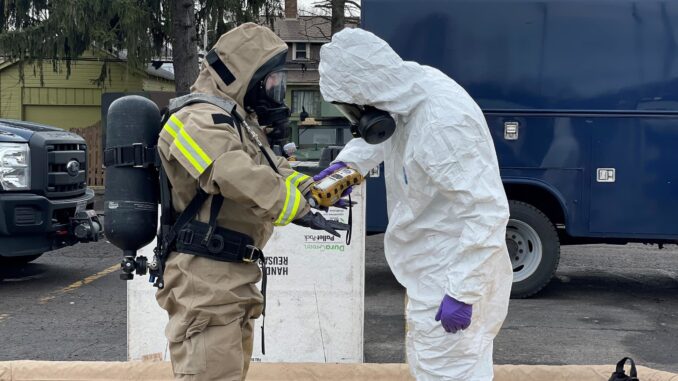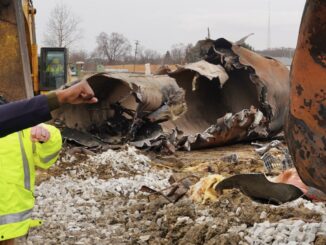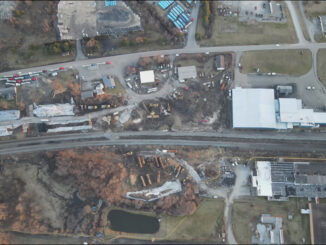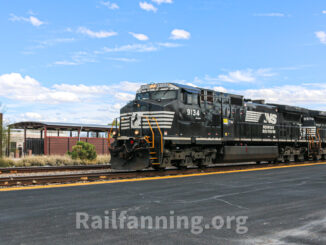
by Kim Lyons, Ohio Capital Journal
June 26, 2024
Norfolk Southern and its contractors erred when they made the call to release and burn toxic chemicals leaking from rail cars following the 2023 derailment of a train in East Palestine, Ohio, the National Transportation Safety Board said during a Tuesday hearing.
In addition, the railroad stymied investigators repeatedly over the course of the 17-month probe, NTSB chair Jennifer Homendy said, and at one point, its representatives made threatening remarks to her about how it would respond to the agency’s findings.
Five of the rail cars had been heated by a fire caused by the derailment, but the railroad failed to detect that the cars’ temperatures had started to drop, making the release unnecessary because the danger of explosion was receding, NTSB investigator Paul Stancil said Tuesday.
In addition, trackside detectors failed to detect how hot the temperature of a wheel bearing on the train had become 20 miles before the derailment occurred, according to the NTSB. Ultimately, the NTSB investigation determined the defective wheel bearing failed and caused the derailment, which led to the fire.
“On behalf of the entire agency, I want to recognize the significant impact that this derailment has had on the community in East Palestine, Ohio, in Darlington, Pennsylvania, and all the surrounding areas throughout the state of Ohio, throughout the state of Pennsylvania,” Homendy said Tuesday.
The agency was presenting its final report on the Feb. 3, 2023 derailment that left residents of the region with health issues and pollution concerns that they say have yet to be fully addressed. The NTSB presented the findings of its 17-month investigation to a full house in East Palestine High School’s auditorium.
“Unfortunately, some have sought to minimize the wide-ranging impacts of this derailment, pointing to the fact that there were no fatalities or injuries, and for this, we are certainly grateful,” Homendy said. “But the absence of a fatality or injury doesn’t mean the presence of safety.”
On Feb. 3, 2023 at about 9:30 p.m., a Norfolk Southern train with about a dozen cars carrying vinyl chloride derailed near the Ohio-Pennsylvania border
In the days that followed, local emergency officials vented and burned vinyl chloride, creating a black cloud of smoke over the surrounding area that could be seen for miles away. As vinyl chloride burns, it breaks down into carbon monoxide and hydrogen chloride.
Mixed with water, hydrogen chloride makes hydrochloric acid, which is toxic to fish. Officials estimated 3,500 fish in nearby waterways were killed in the days following the venting. Burning vinyl chloride also creates a small amount of phosgene gas, a chemical used as a weapon during World War I.
But Norfolk Southern did not inform local first responders about information it had received from OxyVinyl, the manufacturer of the chemicals, whose on-site team had inspected the train cars and found that the risk of explosion was low and the cars were cooling, NTSB investigators found.
“Norfolk Southern and its contractors continued to assert the necessity of a vent-and-burn, even though available evidence should have led them to re-evaluate their initial conclusion,” Stancil said.
As a result, the first responders, including local firefighters, remained at the derailment scene longer than they should have, exposing them to “post-derailment hazards,” NTSB investigator Troy Lloyd said. This meant decision makers at the scene did not have complete information when they agreed to the railroad’s recommendation to vent the chemicals.
During Tuesday’s hearing, investigators also said the use of a type of rail car to transport butyl acrylate, a flammable chemical that caused the fire the evening of the derailment, also contributed to the aftermath of the derailment. The design of the cars, according to the Pipeline and Hazardous Materials Safety Administration, have “a lower ability to survive derailments and fires without releasing its contents compared to current tank car designs.”
DOT 111 tank cars are being phased out of carrying flammable materials as of 2029, although the Rail Safety Act of 2023 would move that date up to 2025.
“The events that eventually led to the vent and burn could’ve been avoided had there been no DOT 111 tank cars carrying combustible and flammable liquids on this train,” Stancil said.
The railroad agreed to pay $310 million in a settlement with the federal government, to pay for violations of the Clean Water act and the costs of the U.S. Environmental Protection Agency’s cleanup efforts at the scene. In April, Norfolk Southern agreed to a $600 million settlement of a class action suit with residents and businesses.
The company did not admit to any liability, wrongdoing or fault in the settlement, which would end all class action claims related to the derailment from residents within a 20-mile radius of the derailment site near the Ohio-Pennsylvania border. For those who choose to participate, the company said in a statement the settlement would also cover personal injury claims within a 10-mile radius of the derailment.
In a report released June 19, environmental researchers said the chemicals released in the aftermath of the derailment affected 16 states, precipitation and pollution data showed.
Norfolk Southern defended its decision-making around the controlled vent-and-burn, saying in a statement Tuesday it made its recommendation based on the information available at the time, and denied that it withheld information.
Homendy said the railroad had attempted to interfere with the NTSB investigation process in a way that was “ unprecedented and reprehensible.” The railroad had repeatedly failed to give information to investigators, or tried to delay giving information, to the point that she twice contacted the railroad and threatened to subpoena the information.
Homendy had testified to some of the NTSB’s findings during a March hearing before the Senate Committee on Commerce, Science and Transportation. Sen. J.D. Vance (R-Ohio) questioned whether the railroad had made the decision to burn off the chemicals in order to get trains back up and running more quickly.
“A lot of people, including me, are wondering, did they do this not because it was necessary, but because it allowed them to move traffic and freight more quickly?” Vance asked during the March hearing.
Homendy said Tuesday that when Norfolk Southern executives met with individual NTSB board members — a routine part of the investigation process — one of the executives told her it was “their hope that in this board meeting and in the community meetings, the NTSB would put to rest the quote, unquote rumor that Norfolk Southern made the decision to vent and burn to move trains,” Homendy said, which she called “unethical and inappropriate.”
She went on to say that the Norfolk Southern representatives told her they would “use every avenue and opportunity to vigorously defend their decision making in media and hearings going forward,” which those in the room at the time interpreted as a threat.
“That is your right, but it is not our role to defend Norfolk Southern, we’re here to protect the American people and the traveling public,” Homendy said.
Norfolk Southern’s media relations team sent a statement to the Capital-Star disputing Homendy’s comments.
“At all times, Norfolk Southern cooperated fully and ethically with the investigation, with full transparency. Our communications with NTSB staff and Board Members were always motivated by a desire to ensure they had all the relevant information for their independent evaluation and by a shared commitment to advance rail safety,” the statement reads.
U.S. Sen. Bob Casey (D-Pa.), a co-sponsor of the Senate version of the Railway Safety Act, said Tuesday he would keep pushing for it to become law.
“Norfolk Southern’s information-sharing failure placed Pennsylvania first responders in needless, irresponsible danger. This final rule is an important step to protect our first responders, but we need to pass legislation that protects our communities from train derailments.” Casey said in a statement.
The Railway Safety Act included a slew of new rules for railroads, including enhancing safety procedures for trains carrying hazardous materials, and raising fines for rail carriers who violate rules, and requiring railroads to operate with crews of at least two people.
Rail carriers would also be required to give advance notice to state emergency response officials about what materials the trains are transporting. The bill, and its companion bill in the House, cosponsored by Pennsylvania U.S. Rep. Chris Deluzio (D-17th District), have not advanced, despite bipartisan support.
The NTSB board approved a series of two dozen recommendations at the conclusion of Tuesday’s daylong hearing. It recommended the Federal Railroad Administration review its rules for trackside detectors and how railroads respond to them, and recommended the agency review the decision making process for conducting future vent-and-burn procedures and ensure first responders are informed.
The NTSB does not have enforcement authority, but has a team that follows up on recommendations to ensure action is being taken by the proper authorities. Its final report will be available for public review in a few weeks.
Pennsylvania Capital-Star is part of States Newsroom, a nonprofit news network supported by grants and a coalition of donors as a 501c(3) public charity. Pennsylvania Capital-Star maintains editorial independence. Contact Editor Kim Lyons for questions: info@penncapital-star.com. Follow Pennsylvania Capital-Star on Facebook and X.
Ohio Capital Journal is part of States Newsroom, a nonprofit news network supported by grants and a coalition of donors as a 501c(3) public charity. Ohio Capital Journal maintains editorial independence. Contact Editor David Dewitt for questions: info@ohiocapitaljournal.com. Follow Ohio Capital Journal on Facebook and X.





